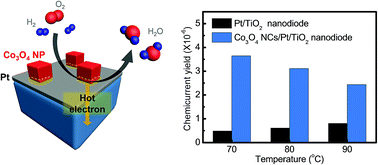当前位置:
X-MOL 学术
›
Faraday Discuss.
›
论文详情
Our official English website, www.x-mol.net, welcomes your feedback! (Note: you will need to create a separate account there.)
Enhanced hot electron generation by inverse metal–oxide interfaces on catalytic nanodiode
Faraday Discussions ( IF 3.4 ) Pub Date : 2018-11-07 , DOI: 10.1039/c8fd00136g Hyosun Lee 1, 2, 3, 4 , Sinmyung Yoon 4, 5, 6, 7 , Jinwoung Jo 2, 4, 8, 9, 10 , Beomjoon Jeon 1, 2, 3, 4, 11 , Taeghwan Hyeon 2, 4, 8, 9, 10 , Kwangjin An 4, 5, 6, 7 , Jeong Young Park 1, 2, 3, 4, 11
Faraday Discussions ( IF 3.4 ) Pub Date : 2018-11-07 , DOI: 10.1039/c8fd00136g Hyosun Lee 1, 2, 3, 4 , Sinmyung Yoon 4, 5, 6, 7 , Jinwoung Jo 2, 4, 8, 9, 10 , Beomjoon Jeon 1, 2, 3, 4, 11 , Taeghwan Hyeon 2, 4, 8, 9, 10 , Kwangjin An 4, 5, 6, 7 , Jeong Young Park 1, 2, 3, 4, 11
Affiliation

|
Identifying the electronic behavior of metal–oxide interfaces is essential for understanding the origin of catalytic properties and for engineering catalyst structures with the desired reactivity. For a mechanistic understanding of hot electron dynamics at inverse oxide/metal interfaces, we employed a new catalytic nanodiode by combining Co3O4 nanocubes (NCs) with a Pt/TiO2 nanodiode that exhibits nanoscale metal–oxide interfaces. We show that the chemicurrent, which is well correlated with the catalytic activity, is enhanced at the inverse oxide/metal (CoO/Pt) interfaces during H2 oxidation. Based on quantitative visualization of the electronic transfer efficiency with chemicurrent yield, we show that electronic perturbation of oxide/metal interfacial sites not only promotes the generation of hot electrons, but improves catalytic activity.
中文翻译:

通过催化纳米二极管上的逆金属-氧化物界面增强了热电子生成
识别金属氧化物界面的电子行为对于理解催化性质的起源和设计具有所需反应性的催化剂结构至关重要。为了机械理解逆氧化物/金属界面处的热电子动力学,我们采用了一种新型的催化纳米二极管,将Co 3 O 4纳米立方体(NC)与具有纳米级金属-氧化物界面的Pt / TiO 2纳米二极管相结合。我们表明,与催化活性很好相关的化学电流在H 2期间在逆氧化物/金属(CoO / Pt)界面处增强。氧化。基于化学流产率的电子转移效率的定量可视化,我们表明氧化物/金属界面部位的电子扰动不仅促进了热电子的产生,而且提高了催化活性。
更新日期:2019-05-29
中文翻译:

通过催化纳米二极管上的逆金属-氧化物界面增强了热电子生成
识别金属氧化物界面的电子行为对于理解催化性质的起源和设计具有所需反应性的催化剂结构至关重要。为了机械理解逆氧化物/金属界面处的热电子动力学,我们采用了一种新型的催化纳米二极管,将Co 3 O 4纳米立方体(NC)与具有纳米级金属-氧化物界面的Pt / TiO 2纳米二极管相结合。我们表明,与催化活性很好相关的化学电流在H 2期间在逆氧化物/金属(CoO / Pt)界面处增强。氧化。基于化学流产率的电子转移效率的定量可视化,我们表明氧化物/金属界面部位的电子扰动不仅促进了热电子的产生,而且提高了催化活性。


























 京公网安备 11010802027423号
京公网安备 11010802027423号